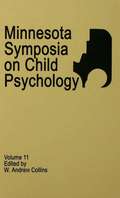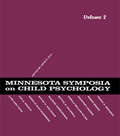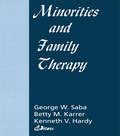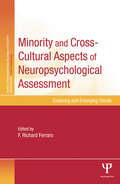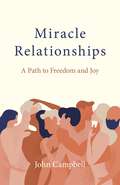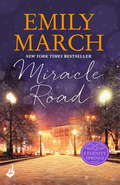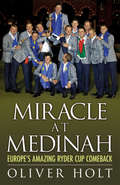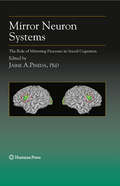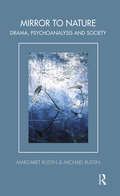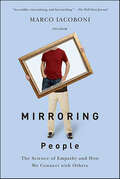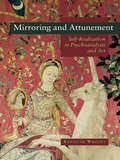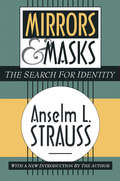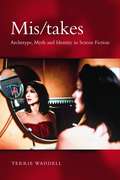- Table View
- List View
Minnesota Symposia on Child Psychology: Volume 11 (Minnesota Symposia on Child Psychology Series #Vol. 21)
by W. Andrew CollinsPublished in 1978, Minnesota Symposia on Child Psychology is a valuable contribution to the field of Developmental Psychology.
Minnesota Symposia on Child Psychology: Volume 2 (Minnesota Symposia on Child Psychology Series)
by John P. HillFirst published in 1981. Routledge is an imprint of Taylor & Francis, an informa company.
Minor Traumatic Brain Injury Handbook: Diagnosis and Treatment
by Gary W. JayAlmost two million individuals experience minor traumatic brain injury (MTBI/MATBI) each year. Patients from all over the country have similar - even identical - complaints from comparable types of trauma. Unfortunately, the vast majority of medical professionals do not recognize or understand the appearance, etiology, or problems associated with M
Minorities and Family Therapy
by Kenneth Hardy Betty Mackune-Karrer George SabaMinorities and Family Therapy highlights the work of experienced, sensitive clinicians who, along with minority families, have found creative solutions to the problems minority families present. Until now, the field of family therapy has paid little attention to the specific clinical needs and strengths of minority families. Without sufficient exploration and training, family therapists risk treating minority families from a narrow, incomplete perspective, filtering out their inner resources, values, legacies, history, and wisdom, and underestimating the influence of the social settings in which they live. This unique and highly valuable book explores how systems-oriented clinicians presently work with ethnic and racial minority families. The chapters cover a wide range of clinical issues including pitfalls of misunderstanding and discrimination, innovative strategies for treating drug abuse and AIDS, and skills needed in caring for particular minority groups, such as Native Americans, blacks, Latinos, and Asian Americans. The authors go beyond simply spelling out cultural similarities and differences. They provide clear, clinical suggestions to be applied in family and community contexts. Not just another book on ethnicity, Minorities and Family Therapy looks at families who, because of their race and cultural background, have had to struggle with racism, discrimination, limited access to health care, economic bankruptcy, and educational barriers. Written for family therapists and health care providers who work with minority families and look for creative alternatives to improve their care, this landmark volume is a celebration of the strengths that minority families demonstrate in coping with long-term adversity.
Minority Influence and Innovation: Antecedents, Processes and Consequences
by Robin MartinSocial groups form an important part of our daily lives. Within these groups pressures exist which encourage the individual to comply with the group’s viewpoint. This influence, which creates social conformity, is known as ‘majority influence’ and is the dominant process of social control. However, there also exists a ‘minority influence’, which emerges from a small subsection of the group and is a dynamic force for social change. Minority Influence and Innovation seeks to identify the conditions under which minority influence can prevail, to change established norms, stimulate original thinking and help us to see the world in new ways. With chapters written by a range of expert contributors, areas of discussion include: processes and theoretical issues the factors which affect majority and minority influence interactions between majority and minority group members This book offers a thorough evaluation of the most important current developments within this field and presents consideration of the issues that will be at the forefront of future research. As such it will be of interest to theorists and practitioners working in social psychology.
Minority Student Retention: The Best of the "Journal of College Student Retention: Research, Theory & Practice"
by Alan SeidmanStudent retention continues to be a vexing problem for all colleges and universities. In spite of the money spent on creating programs and services to help retain students until they achieve their academic and personal goals, and graduate, the figures have not improved over time. This is particularly true for minority students, who have a greater attrition rate than majority students. Demographic information shows that the minority population in the United States is growing at a faster rate than the majority. It is imperative that educational institutions find ways to help improve retention rates for all students but particularly minority students. Retention rates should not differ appreciably among different racial/ethnic groups."The Journal of College Student Retention: Research, Theory and Practice" is the only scholarly, peer-reviewed journal devoted solely to college student retention. It has published many articles on minority student retention, and this topic continues to garner much attention. This book is a compilation of the very best of these articles, selected on the basis of reviews by a cadre of experts in the education field. The articles discuss African American, Latino/Latina, Asian and Asian Pacific, Native American, and biracial students, and institutional commitments to retaining a diverse student population. For those interested in this vital area, the collection will teach and inspire them to achieve greater heights and pay additional attention to retaining minority students in our colleges and universities.
Minority and Cross-Cultural Aspects of Neuropsychological Assessment: Enduring and Emerging Trends (Studies on Neuropsychology, Neurology and Cognition)
by F. Richard FerraroMinority and cross-cultural psychology is more relevant now than ever in our diverse world. Given the dramatic local and global changes occurring daily with regard to demographics, population changes, and immigration issues, minority and cross-cultural psychology is fast becoming a respected and critical area of scientific study. Pair that with the fact that people of all cultures and racial groups are living longer and experiencing age-related diseases and disorders, one can easily see the need for additional work on issues related to neuropsychological assessment. This new edition brings to the forefront recent developments by seasoned experts in the field. They offer up their newest projects in minority and cross-cultural aspects of neuropsychological assessment and are joined by new, up-and-coming professionals across a wide array of disciplines including psychology, medicine, and neuropsychology. Like the first edition, this updated collection sheds light on the ever-growing need for adequate neuropsychological assessment to a wider subset of individuals, crossing many cultural and minority barriers in the process. Continuously pushing the boundaries of neuropsychological assessment, this collection is essential reading for cognitive and clinical psychologists, and neuropsychologists, and a model text for advanced courses dealing with minority and cross-cultural issues.
Miracle Moments: Helping the Rescued Become the Rescuers
by Renee Vajko Srch<p>Inspiring stories of how both people and dogs with the odds stacked against them give each other a new start in life from the founder of Dog’s Nation.<p> <p>When Shawn Abell founded Dog’s Nation, her purpose was to save dogs and train them as service dogs for individuals with Autism Spectrum Disorder or veterans suffering from Post-Traumatic Stress Disorder. In pairing these dogs with individuals with special needs, Dog’s Nation ultimately saves two lives instead of just one.<p> <p>Miracle Moments offers readers the opportunity to meet some of the special animals Dog’s Nation has rescued. There’s Jack who gently coaxed a veteran with PTSD out of the darkness where he’d been living for so long; Max, a scruffy little terrier who brought emotional healing to a girl with autism; Amy, a terrier-mix who averted a near-drowning; Charm, a golden retriever who gave an autism family a new lease on life; and so many more true stories that will inspire and warm your heart.<p>
Miracle Relationships: A Path to Freedom and Joy
by John CampbellWhat courses do intimate relationships usually take? And why do they often seem to go wrong? A concise, brief guide aimed at finding and maintaining peaceful, harmonious relationships, Miracle Relationships: A Path to Freedom and Joy will help you understand the purpose of these relationships and the gifts they have to offer. Understand the healing opportunities in every relationship and the real reason we choose the partners we choose. End the cycle of repeated painful patterns and discover that there is no 'failed' relationship.
Miracle Road: A heartwarming, uplifting, feel-good romance series (Eternity Springs #7)
by Emily MarchIf you love Robyn Carr's Virgin River, don't miss Emily March's warm, uplifting Eternity Springs series!Miracle Road is the beautiful seventh novel in New York Times bestselling author Emily March's warm and uplifting romance series about a small town with a big heart. For fans of Debbie Macomber, Holly Martin and Sheryl Woods.After tragedy strikes his team, college basketball coach Lucca Romano arrives in Eternity Springs to reassess his life. It seems nothing can breach his wall of guilt - except maybe a vibrant new neighbour who won't give up on him.Schoolteacher Hope Montgomery has to believe in miracles because giving up would mean crumbling under the greatest loss a parent can endure. Understanding Lucca's suffering, she sets out to draw him from his solitary shell. But when a weak moment leads to consequences that shake Hope's faith, it's up to Lucca to put aside his heartache and show her that in Eternity Springs broken hearts can mend - just in time for Christmas.Escape to Eternity Springs, a little piece of heaven in the Colorado Rockies, with the other books in the series, Hummingbird Lake, Heartache Falls, Mistletoe Mine, Lover's Leap, Nightingale Way, Reflection Point, Miracle Road, Dreamweaver Trail, Teardrop Lane, Heartsong Cottage, Reunion Pass, Christmas In Eternity Springs.
Miracle at Medinah: Europe's Amazing Ryder Cup Comeback
by Oliver HoltGolf fans will not forget the 39th Ryder Cup in a hurry. Staged at the Medinah Country Club just outside of Chicago, the 2012 event has already gone down as the most remarkable competition in its 85-year history. The American team had home advantage, and a golf course unapologetically set up to suit its own players. Supported by tens of thousands of loud and proud fans, the USA's star-studded line-up dominated the first two days and ended the Saturday with a seemingly unassailable 10-6 advantage. No away team had ever won the Ryder Cup from such an unpromising position. Sunday was singles day, traditionally the forte of American teams. The situation looked bleak, especially when European team member and number 1 golfer in the world, Rory McIlroy, very nearly missed his tee-off time. Yet slowly but surely, the European team - who had top-loaded their line-up in one last throw of the dice - started to turn the scoreboard blue. With inspirational captain Jose Maria Olazabal stiring European blood with thoughts of the late Ryder Cup magician Seve Ballesteros (whose silhouette was emblazoned on the players' sweaters and bags), the tide turned and the previously dominant American players started to crumble in the face of the onslaught. Suddenly European players were holing miraculous putts to win holes out of the blue. Something very special was happening. When German Martin Kaymer sank his putt on the eighteenth green to clinch the point that retained the Ryder Cup, the most astonishing comeback in the event's long and distinuished history was complete. Miracle at Medinah is the compelling narrative of those amazing three days in Illinois, a fitting chronicle of an unbelievable sporting story.
Mirror Neuron Systems
by Jaime A. PinedaThe discovery of mirror neurons and of a mirror neuron system in the human brain raises the interesting possibility that "mirroring" may constitute novel instances of mental simulation. It also provides the basis for unique processes such as "mindreading", the ability to make inferences about the actions of others. That an elementary process in motor cognition may be foundational to mindreading goes a long way in providing a rational basis for the study of social cognition. Social cognition is a broad discipline that encompasses many issues not yet adequately addressed by neurobiologists. In Mirror Neuron Systems: The Role of Mirroring Processes in Social Cognition, leading thinkers in this nascent field craft chapters aimed at sparking a dialogue regarding the relevance of mirroring neural systems in cognition. Thought-provoking and cutting-edge, Mirror Neuron Systems: The Role of Mirroring Processes in Social Cognition provides the basis for extended discussion among interested readers and lays down the guidelines for future research in this fascinating and expanding field. It addresses issues common to different perspectives, raises contrary views, and creates the basis for an extended dialogue and discussion.
Mirror for the Soul: A Christian Guide to the Enneagram
by Alice Fryling"Who in the world am I?" The Enneagram is like a mirror, reflecting dimensions of ourselves that are sometimes hard to see. In this helpful guide, spiritual director and Enneagram teacher Alice Fryling offers an introduction to each number of the Enneagram and their respective triads. More than just helping us discern our number, this book relates the Enneagram to our spiritual journey, as a way to identify our gifts as well as our blind spots. With Scripture meditations and questions for reflection and discussion, Mirror for the Soul offers a new perspective on our unique temperament so that we might know and extend God's grace more fully. Knowledge of the Enneagram leads us into more authentic self-awareness, richer relationships, and deeper places in the soul where we can worship God in truth and grace.
Mirror to Nature: Drama, Psychoanalysis and Society (Tavistock Clinic Series)
by Michael Rustin Margaret RustinThis book brings the insights of psychoanalysis to bear on drama in the western dramatic tradition. Plays which are discussed in detail include works by Shakespeare, Ibsen, Chekhov, Wilde, and Beckett among others. The authors seek to show that the subtle understanding of conscious and unconscious emotions achieved by psychoanalytic practice can bring new ways of understanding classic works of drama. The argument of the book, set out in its introduction and exemplified in its discussion of individual dramatists and plays, is that western drama has represented the central tensions of societies as crises in the relationships of gender and generation, through dramatic explorations of the inner life of families. This is the common theme which links the book's analysis of Medea, Macbeth and A Midsummer Night's Dream amongst others. The value of this book lies in the originality of its analysis of individual plays, and the subtlety with which it brings psychoanalytic and sociological insights together.
Mirroring People: The Science of Empathy and How We Connect with Others
by Marco IacoboniWhat accounts for the remarkable ability to get inside another person's head—to know what they're thinking and feeling? "Mind reading" is the very heart of what it means to be human, creating a bridge between self and others that is fundamental to the development of culture and society. But until recently, scientists didn't understand what in the brain makes it possible.This has all changed in the last decade. Marco Iacoboni, a leading neuroscientist whose work has been covered in The New York Times, the Los Angeles Times, and The Wall Street Journal, explains the groundbreaking research into mirror neurons, the "smart cells" in our brain that allow us to understand others. From imitation to morality, from learning to addiction, from political affiliations to consumer choices, mirror neurons seem to have properties that are relevant to all these aspects of social cognition. As The New York Times reports: "The discovery is shaking up numerous scientific disciplines, shifting the understanding of culture, empathy, philosophy, language, imitation, autism and psychotherapy." Mirroring People is the first book for the general reader on this revolutionary new science.
Mirroring and Attunement: Self-Realization in Psychoanalysis and Art
by Kenneth WrightMirroring and Attunement offers a new approach to psychoanalysis, artistic creation and religion. Viewing these activities from a broadly relational perspective, Wright proposes that each provides a medium for creative dialogue: the artist discovers himself within his self-created forms, the religious person through an internal dialogue with ‘God’, and the analysand through the inter-subjective medium of the analysis. Building on the work of Winnicott, Stern and Langer, the author argues that each activity is rooted in the infant’s preverbal relationship with the mother who ‘holds’ the emerging self in an ambience of mirroring forms, thereby providing a ‘place’ for the self to ‘be’. He suggests that the need for subjective reflection persists throughout the life cycle and that psychoanalysis, artistic creation and religion can be seen as cultural attempts to provide the self with resonant containment. They thus provide renewed opportunities for holding and emotional growth. Mirroring and Attunement will provide essential reading for psychoanalysts, psychotherapists, and art therapists and be of interest to anyone working at the interface between psychoanalysis, art and religion.
Mirrors and Masks: The Search for Identity
by Anselm L. StraussIdentity as a concept is as elusive as everyone's sense of his own personal identity. It is connected with appraisals made by oneself and by others. Each person sees himself mirrored in the judgments of others. The masks he presents to the world are fashioned upon his anticipations of judgments. In Mirrors and Masks, Anselm Strauss uses the notion of identity to organize materials and thoughts about certain aspects of problems traditionally intriguing to social psychologists.The problems Strauss considers to be intriguing traditionally are those encountered when studying group membership, motivation, personality development, and social interaction. The topics covered include: the basic importance of language for human action and identity; the perpetual indeterminacy of identities in constantly changing social contexts; the symbolic and developmental character of human interaction; the theme of identity as it affects adult behaviqr; relations between generations and their role in personality development; and the symbolic character of membership in groups.By focusing on symbolic behavior with an emphasis on social organization, Strauss presents a fruitful, systematic perspective from which to view traditional problems of social psychology. He opens up new areas of thought and associates matters that are not ordinarily considered to be related. Strauss believes that psychiatrists* and psychologists underestimate immensely the influence of social organization upon individual behavior and individual structure, and that sociologists, whose major concern is with social organization, should employ some kind of social psychology in their research. Mirrors and Masks shows that the fusion of theoretical approaches benefits the analyses of many scholars. This fascinating work should be read by sociologists, anthropologists, psychologists, and psychiatrists.
Mirrors and Reflections: Processes of Systemic Supervision (The Systemic Thinking and Practice Series)
by Gwyn Daniel Charlotte BurckIn this volume, as the title indicates, the focus is on understanding and elaborating what might be said to be "going on" in supervision as well as further exploring what is distinctive about systemic supervision. Looking at processes within systemic supervision involves engaging with the different contexts within which the supervision takes place and engaging with a range of theories - some developed or applied within therapeutic contexts and others drawn from theories of learning. Various theoretical frameworks have emerged and been described as underpinnings for systemic supervision. Social constructionist and narrative ideas have been vital in the creation of supervisory practices that promote open dialogues, multiple perspectives and the interrogation of traditional assumptions about expertise and hierarchy. This has inevitably led to a discussion of tensions and contradictions: unease about implicit practices of power, the problematics of assessment and evaluation and issues concerning the allocation of clinical responsibility. Positioning theory, dialogic theories and ideas from the field of adult education have also contributed helpful theoretical concepts for use by systemic supervisors.
Mirrors of Madness: Patrolling the Psychic Border (Social Problems And Social Issues Ser.)
by Bruce LuskeMirrors of Madness depicts the social-psychological processes and institutional consequences of psychiatric staffs experience of ""closet insanity"" (private worries about theirown social and psychological competence) and ""reverse role modeling"" (identification with their labeled psychotic clients' public behavior).The book shows how, in attempting to ward off the threat involved in these processes, staffs tend to be more vigilant of their own behavior while redirecting their insecurities toward their clients in the form of derogatory humor in psychiatric evaluations. These and other activities are shown to be inhibiting factors in the rehabilitative function of social control agencies.
Mirrors of the Self: Archetypal Images That Shape Your Life
by Christine DowningThis new Consciousness Reader is part of a new series of original and classic writing by renowned experts on leading-edge concepts in personal development, psychology, spiritual growth, and healing.
Mis/takes: Archetype, Myth and Identity in Screen Fiction
by Terrie WaddellMis/takes departs from the bulk of screen discourse by applying Jungian and Post-Jungian ideas on unconscious processes to popular film and television. This perspective offers a rich insight into the way that various myths infiltrate popular culture. By examining the function of psychological motifs and symbols in cinema and television, Terrie Waddell opens up another way of thinking about how identity can be constructed and disrupted. Mulholland Drive, Memento, The Others, The X-Files, Twin Peaks, The Sopranos, Spider, Intimacy and Absolutely Fabulous all lend themselves to this approach. The close analysis of these films/programs are guided by a number of core archetypes from trickster and Self to incest and the grotesque. The book’s four parts reflect these dominant patterns: Jung, trickster and the screen Mistaken identities, self-deception and the undead Redeemers, bad dads and matricide Excesses of the sad and the sassy Mis/takes gives readers a chance to engage with screen material in an original and subversive way. This study will be of great interest to Jungian analysts and students of film, cultural studies, media, gender studies and analytical psychology.
Misadventures in Health Care: Inside Stories
by Marilyn Sue BognerMisadventures in Health Care: Inside Stories presents an alternative approach to attributing the cause of medical error solely to the health care provider. That alternative, the systems approach, pursues why an incident occurs in terms of factors in the context of care that affect the care provider to induce an error. The basis for this approach is the fact that an error is an act, an act is behavior, and behavior is a function of the person interacting with the environment. Eleven vignettes illustrate the importance of the systems approach by describing health care incidents from the perspective of the care providers--the perspective that can identify the factors that actually affect the provider. These stories provide general readers with opportunities to apply their knowledge in analyzing incidents to identify error-inducing factors. This book is important reading for policymakers, researchers and practitioners in law and in all medical specialties, and professionals in the social sciences, human factors, and engineering. In addition to sensitizing the reader to the importance of contextual factors in error, Misadventures in Health Care is a case study reference to supplement texts in professional schools such as law and medicine, as well as the full range of academic disciplines. It also is important reading for the general public because it presents an approach for addressing a very pressing social problem-- that of misadventures in health care.
Misbehavior in Organizations: A Dynamic Approach (Applied Psychology Series)
by Yoav Vardi Ely WeitzThis revised edition of Misbehavior in Organizations updates and expands upon the integrative OMB (organizational misbehavior) framework pioneered by the authors. Streamlined for improved readability, it covers key topics that have emerged in the scholarly literature in the past decade including insidious workplace behavior, bullying and harassment in the workplace, information hiding, cyberbullying, and organizational spirituality. A thorough and up-to-date resource on this crucial and evolving topic in organizational studies, this book provides insights on misbehavior at the individual, position, group, and organizational levels.
Misbelief: What Makes Rational People Believe Irrational Things
by Dr. Dan ArielyThe renowned social scientist, professor, and bestselling author of Predictably Irrational delivers his most urgent and compelling book—an eye-opening exploration of the human side of the misinformation crisis—examining what drives otherwise rational people to adopt deeply irrational beliefs. Misinformation affects all of us on a daily basis—from social media to larger political challenges, from casual conversations in supermarkets, to even our closest relationships. While we recognize the dangers that misinformation poses, the problem is complex—far beyond what policing social media alone can achieve—and too often our limited solutions are shaped by partisan politics and individual interpretations of truth.In Misbelief, preeminent social scientist Dan Ariely argues that to understand the irrational appeal of misinformation, we must first understand the behavior of “misbelief”—the psychological and social journey that leads people to mistrust accepted truths, entertain alternative facts, and even embrace full-blown conspiracy theories. Misinformation, it turns out, appeals to something innate in all of us—on the right and the left—and it is only by understanding this psychology that we can blunt its effects. Grounded in years of study as well as Ariely’s own experience as a target of disinformation, Misbelief is an eye-opening and comprehensive analysis of the psychological drivers that cause otherwise rational people to adopt deeply irrational beliefs. Utilizing the latest research, Ariely reveals the key elements—emotional, cognitive, personality, and social—that drive people down the funnel of false information and mistrust, showing how under the right circumstances, anyone can become a misbeliever.Yet Ariely also offers hope. Even as advanced artificial intelligence has become capable of generating convincing fake news stories at an unprecedented scale, he shows that awareness of these forces fueling misbelief make us, as individuals and as a society, more resilient to its allure. Combating misbelief requires a strategy rooted not in conflict, but in empathy. The sooner we recognize that misbelief is above all else a human problem, the sooner we can become the solution ourselves.
Misdiagnosis and Dual Diagnoses of Gifted Children and Adults
by James Webb Edward R. Amend Nadia E. Webb Jean Goerss Paul Beljan F. Richard OlenchakDescribes how to guard against misdiagnosing gifted children and adults, and how to treat gifted persons with and without dual diagnoses.
